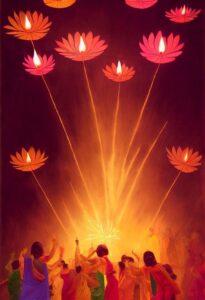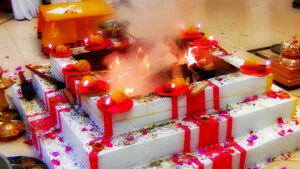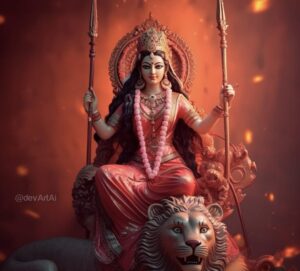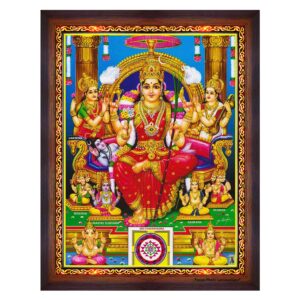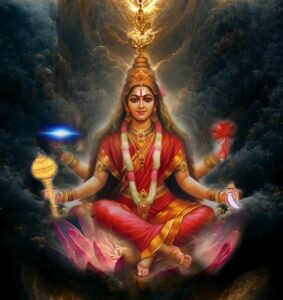Mahagauri, the eighth form of Goddess Durga, is the epitome of purity and serenity. She goes by various names, such as Shwetambardhara (adorned in white attire), Vrisharudha (mounted on a bull), Chaturbhuji (possessing four arms) and Shambhavi (bestower of bliss and happiness).As we delve into the spiritual journey of Navaratri, let’s explore the divine presence and significance of Mahagauri.

Mahagauri’s Radiant Form
Her radiant complexion is often likened to the purity of the conch, the serene moon and the fragrant jasmine flowers. (‘Maha’ signifies great, and ‘Gauri’ represents white). Mahagauri is seated atop a white bull and she is typically depicted with three eyes and four arms. Two of her arms, positioned in varada (granting boons) and abhay (dispelling fear) mudras, symbolize her blessings and the removal of fear from the lives of her devotees. Her other two arms gracefully hold a trident and a tambourine (damru). She adorns herself with garments and ornaments of the utmost purity, which are all in white.
The Emergence of Mahagauri: The Divine Austerity
From Darkness to Radiance
In the forested realms of the Himalayas, Goddess Parvati embarked on an arduous journey to unite with her beloved Lord Shiva. She sought to attain an unparalleled state of penance and devotion, which would ultimately bring her the supreme blessing she longed for. However, the rigorous austerity she practiced in the pristine and isolated mountains had a profound effect on her appearance.
As Parvati delved deeper into her penance, her skin began to adopt a dark complexion. Her devotion was unwavering and her asceticism intense. This transformation of her physical form became a symbol of her unwavering commitment to her divine purpose.
The Divine Union and Cleansing
The Benevolent Touch of Lord Shiva
Intrigued and moved by Parvati’s devotion, Lord Shiva, the mighty ascetic of the Himalayas, chose to grace her with his divine presence. It was in his radiant aura that the transformation of Parvati’s skin took place. The darkened skin, symbolic of her rigorous penance, regained its natural beauty as Lord Shiva washed it with the pure waters of the sacred Ganges River.
As a result, Parvati, now adorned with a luminous complexion, came to be known as “Maha Gauri,” which translates to “extremely white.” The ethereal beauty and radiance of Maha Gauri was akin to the sparkling white crystal, a symbol of purity and grace.
Defeating Darkness: Legends of Demons
The Fierce Form of Maha Gauri
Another tale of Mahagauri tells of her fierce form, which was destined to confront and kill powerful demons. Shumbha and Nishumbha, menacing figures who could only be defeated by a fierce aspect of Parvati, were wreaking havoc in the world. It was time for Maha Gauri to reveal her might.
As her compassion transformed into ferocity, her divine consort, Lord Shiva, called her Kali (dark-complexioned). This however, left her feeling displeased. Seeking to regain her original form, Parvati embarked on another profound austerity and prayer. Her devoted efforts won her the blessings of Lord Brahma.
From Dark to Divine: Kaushiki’s Birth
The Purity of the Himalayan Waters
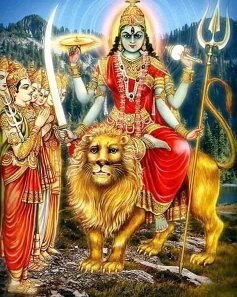
Brahma, pleased with Parvati’s devotion and her desire to regain her pristine form, instructed her to bathe in the sacred Mansarovar in the Himalayas. As Parvati immersed herself in the divine waters of Mansarovar, her dark skin began to shed, emerging as a separate goddess called Kaushiki.
This transformation granted Parvati her original, radiant and pure form. With her dark skin replaced by luminosity, Maha Gauri was whole once more.
The Slayer of Demons and the Ultimate Union
The Divine Transformation
Maha Gauri took on the formidable task of vanquishing the malevolent demons Chanda, Munda, Raktabeeja and Shumbha-Nishumbha. With the blessings of Goddess Lakshmi and Saraswati, she assumed various fierce forms, including Kali, Chandi, Chamunda and Kaalratri, to defeat these demonic forces.
Once her mission was accomplished and all the demons had been vanquished, Maha Gauri reunited with Parvati. The goddesses Chandi, Chamunda, Kali, Kaushiki and Maha Gauri merged into one, symbolizing the ultimate union of divine energies.
The Benevolent Goddess of Kindness
The Pure Goddess of Blessings
Maha Gauri, with her remarkably fair complexion, is often compared to the conch, the soothing moon and the purity of the white Kunda flower. She is depicted seated on a bull, symbolizing strength and possesses four arms.
Maha Gauri’s benevolent right hand provides solace, while her lower right hand holds a trident, symbolizing her power. Her upper left hand holds a ‘damaru,’ a small drum and her lower left hand grants boons to her devoted worshippers.
Method of Worship:
- Meditation and Purity: Begin your worship by purifying your mind and body through meditation. Sit in a calm and quiet place, focus on your breath and clear your mind of distractions.
- Set Up the Altar: Create a sacred space or altar with a picture or idol of Goddess Mahagauri. Decorate it with fresh white flowers, incense and a white cloth.
- Light a Lamp: Light a diya (lamp) or a white candle in front of the Goddess to symbolize the dispelling of darkness and the arrival of divine light.
- Offerings: Offer white clothes, white sweets (such as coconut or mithai) and milk to the Goddess as a symbol of purity.
- Chant Mantras: Chanting mantras is a powerful way to connect with the Goddess.
Mantras to Chant:
- Mahagauri Mantra:
- “Om Devi Mahagauriyai Namah”
- Translation: “I bow to the Goddess Mahagauri.”
- Durga Mantra:
- “Om Dum Durgaye Namah”
- Translation: “I bow to the Goddess Durga.”
- Gauri Mantra:
- “Om Shri Gauriyai Namah”
- Translation: “I bow to the Goddess Gauri.”
- Mahakali Mantra:
- “Om Kreem Kalikayai Namah”
- Translation: “I bow to the Goddess Mahakali.”
- Navaratri Mantra:
- “Om Aim Hreem Kleem Chamundaye Vichche”
- Translation: This is a powerful mantra dedicated to Goddess Chamunda, seeking her blessings.
Prayer and Offerings:
- Close your eyes, focus on the Goddess and offer your heartfelt prayers. Seek her blessings for peace, purity and strength in your life.
- Offer the white sweets to the Goddess and then distribute them as prasad (blessed food) among your family members or friends.
- Light the incense and circulate it in a clockwise direction in front of the idol or picture.
- Conclude your worship with deep gratitude and a sense of devotion.
Remember to perform the worship with a pure heart and devotion. These mantras and rituals can help you connect with the divine energy of Goddess Mahagauri, seeking her blessings for purity and radiance in your life.
Transformation and Liberation
Worshipping Maha Gauri is believed to lead to purification of the soul, liberation from past sins, and spiritual transformation. Her presence signifies purity, serenity and forgiveness. Devotees seek her blessings for solace, inner peace and freedom from negativity.
Maha Gauri’s grace cleanses the spirit, removes impurities and eliminates ignorance. She is the embodiment of peace and harmony, guiding her devotees toward a path of virtue, self-awareness and self-realization.
The Astral Connection: Mitigating Rahu’s Influence
Devotees worship Maha Gauri on the eighth day of Navaratri, which is associated with the planet Rahu. It is believed that her blessings can mitigate the malefic effects of Rahu, bringing astrological harmony and balance to one’s life.
The Mother of All
Maha Gauri is the motherly deity who nurtures and protects her devotees with unconditional love. Her compassionate nature offers solace and support during life’s trials and tribulations.
Conclusion: Radiant in White
Maha Gauri, the radiant goddess of purity and kindness, stands as a symbol of divine grace and inner transformation. Her story teaches us that devotion, perseverance and purity can lead to the ultimate union with the divine, transcending darkness to embrace luminosity.
Author,
Sivalenka Neeraja

